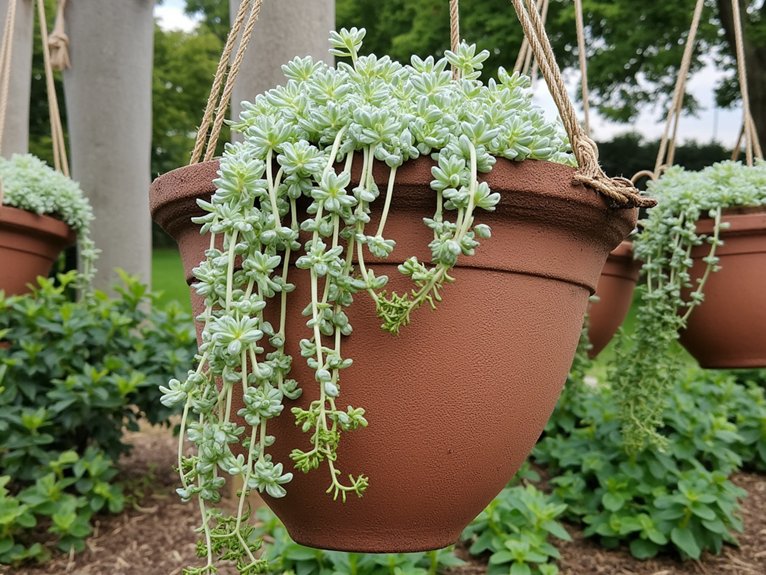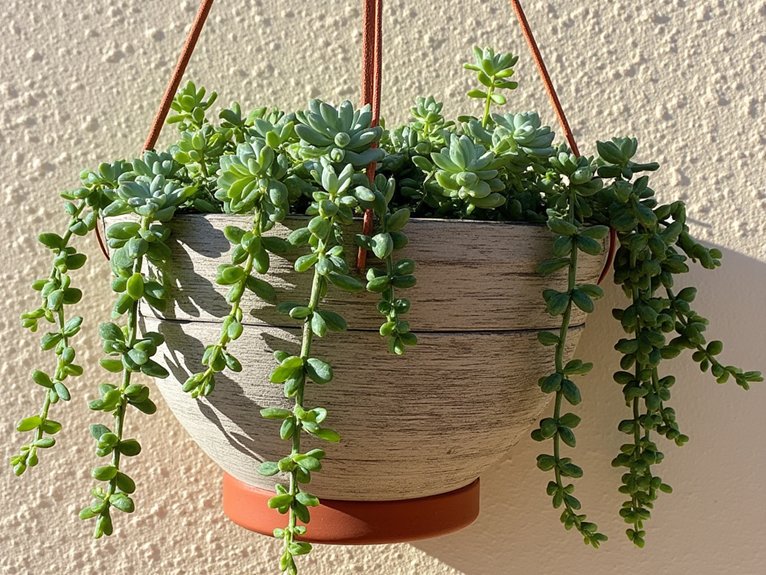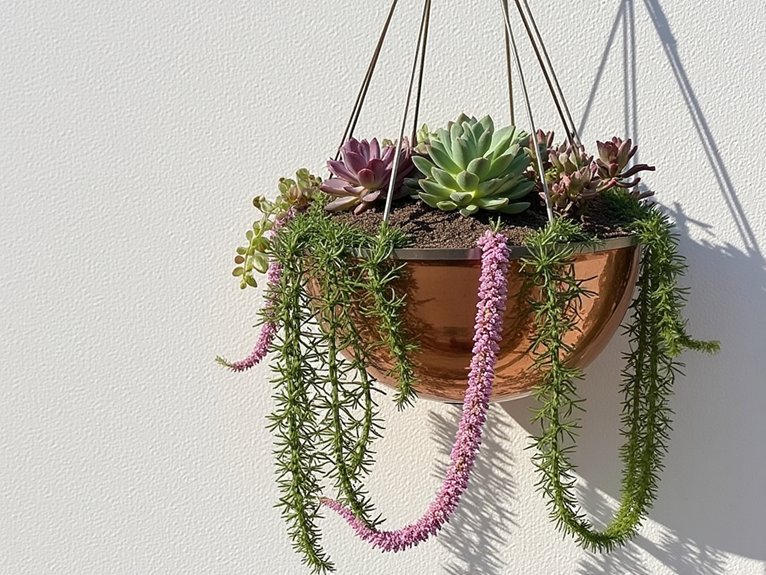Hanging succulents transform ordinary spaces into living art displays through their unique trailing patterns and minimal care requirements. According to botanist Dr. Sarah Chen, “These adaptable plants can thrive in various indoor conditions while creating dramatic cascading effects.” Different varieties offer distinct textures and growth habits, from the pearl-like strings of Senecio rowleyanus to the dolphin-shaped leaves of Curio peregrinus. The key to success lies in understanding their specific needs and ideal growing conditions.
Contents
Why Trailing Succulents Make Perfect Hanging Plants

While many plants can thrive in hanging baskets, trailing succulents offer unique advantages that make them particularly well-suited for suspended displays. Their cascading growth patterns create dramatic visual appeal, with stems that can extend several feet downward. These trailing varieties require minimal maintenance due to their water-storing capabilities and drought-resistant nature.
The compact root systems of trailing succulents prevent them from becoming pot-bound, while their slow growth guarantees displays remain manageable. Their ability to adapt to varying light conditions and survive occasional neglect makes them practical choices for elevated planters that may be challenging to reach for regular care.
Top Cascading Succulents for Your Indoor Garden
When designing an indoor hanging garden, several enchanting succulent varieties offer stunning cascading displays that transform ordinary spaces into living works of art. Among the most unique varieties are the String of Dolphins, with its playful leaf shapes, and the Ghost Plant’s ethereal blue-gray rosettes.
For ideal growth, these trailing beauties require bright indirect light and well-draining soil. “Most cascading succulents are surprisingly easy to propagate from stem cuttings,” notes botanist Dr. Sarah Chen. “Simply allow the cutting to callus for 24 hours before planting in moistened cactus mix.”
Essential Care Tips for Hanging Succulent Gardens

Several key factors contribute to the successful care of hanging succulent gardens, starting with proper placement and watering techniques. Most trailing succulents require bright, indirect light and well-draining soil to thrive. Experts recommend checking soil moisture weekly and adjusting watering frequency based on seasonal changes.
Essential care guidelines:
- Water thoroughly when soil becomes completely dry
- Position baskets where plants receive 4-6 hours of filtered sunlight daily
- Use containers with drainage holes
- Monitor leaf color and growth patterns to assess light requirements
- Protect from cold drafts and frost
- Fertilize lightly during growing season
Creating the Right Growing Environment
The right growing environment makes all the difference between struggling succulents and thriving cascading displays. Most trailing succulents prefer bright, indirect light, though some species like Trailing Jade can handle full sun exposure. Humidity requirements vary greatly – while Christmas Cactus and Mistletoe Cactus thrive in high humidity, String of Pearls prefers drier conditions.
Create ideal conditions by:
- Placing baskets near east or west-facing windows
- Installing sheer curtains to filter harsh sunlight
- Using humidity trays for moisture-loving varieties
- Maintaining temperatures between 65-80°F
- Ensuring proper air circulation around plants
Pairing and Arranging Trailing Succulents

Creating visually stunning hanging displays starts with thoughtful combinations of trailing succulents that complement each other’s growth habits and colors. When selecting pairs, consider contrasting textures like the delicate String of Pearls alongside the bold leaves of Elephant Bush. Fast-growing varieties like Burro’s Tail work well with slower specimens like Ghost Plant.
For ideal color combinations, pair purple-tinged Ruby Necklace with the silvery-blue leaves of Trailing Jade. Plant heights should vary, with longer trailers like Mistletoe Cactus (up to 30 feet) positioned near the basket’s edge and shorter varieties like Dancing Bones centered for balance.
Seasonal Changes and Maintenance Guide
Maintaining trailing succulents through seasonal changes requires adjusting care routines to match natural growth cycles and environmental shifts. From spring through fall, plants need regular monitoring of soil moisture, while winter demands reduced watering and protection from cold drafts.
Seasonal pruning helps manage growth and prevent legginess, particularly before the active growing season begins. Temperature fluctuations can trigger color changes in species like Ruby Necklace and Trailing Jade, signaling the need for care adjustments. During winter months, moving plants away from cold windows and reducing fertilization helps prevent stress, while summer may require additional shade protection and increased humidity levels.
